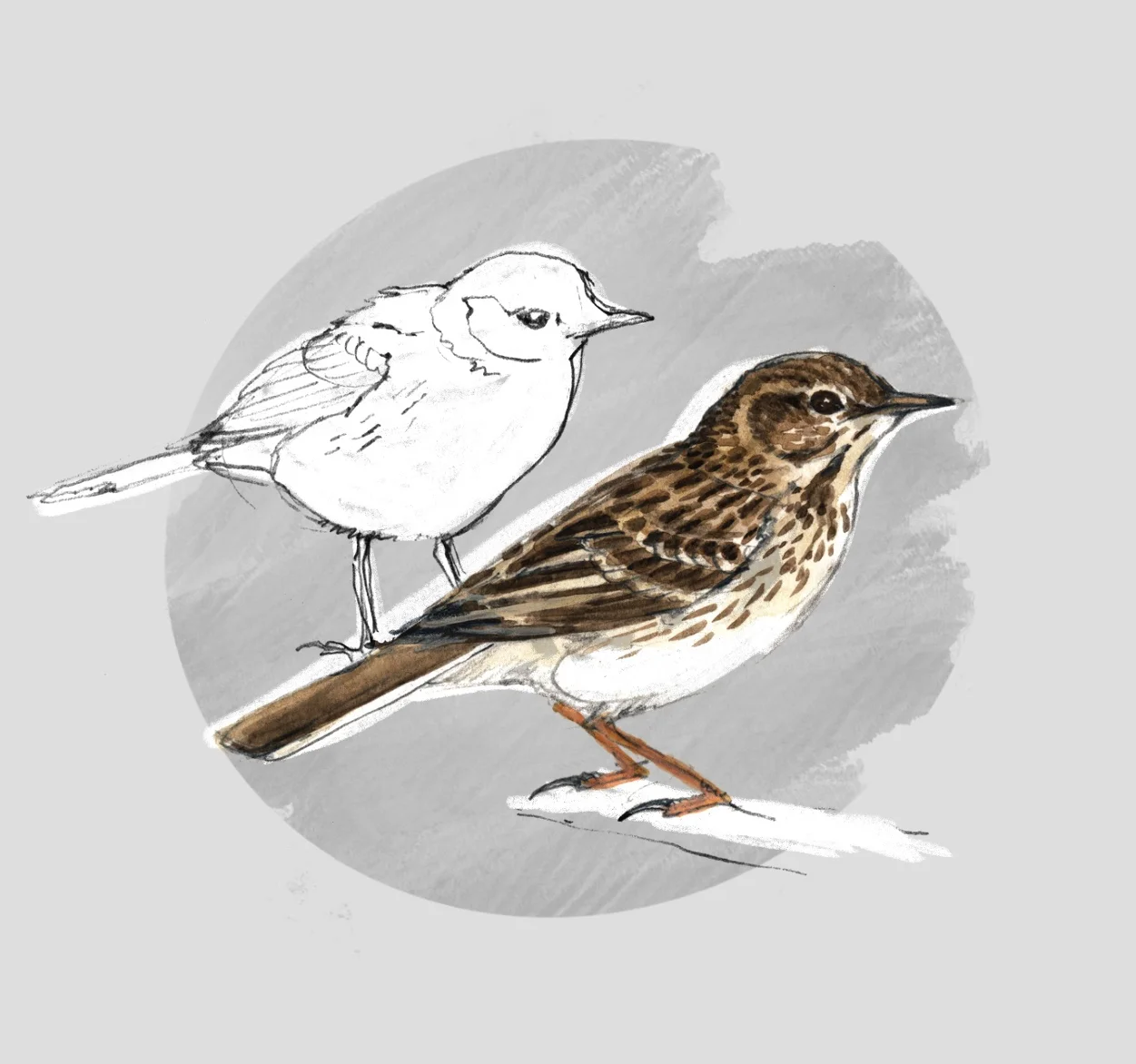A small inconspicuous bird of upland areas and open grassland, more often heard rather than seen.
All tagged small
All Birds
WATER PIPIT (Anthus spinoletta) - Pipit spioncelle
A small inconspicuous bird of upland areas and open grassland, easily confused with the Meadow Pipit it has a similar, but slightly different, display song.
TREE PIPIT (Anthus trivialis) - Pipit des arbres
A pipit with fairly bold markings, found in open forests and forest edge. Easily identified by very clear elements in its liquid song.
WHITE WAGTAIL (Motacilla alba) - Bergeronnette grise
An active bird usually seen around farmyards, forest edges and fields with cattle, chasing large flies. It has a penetrating "tchi-ssik" call.
WREN (Troglodytes troglodytes) - Troglodyte mignon
A very common species found in a wide variety of habitats right up to the mountain tops. It has an energetic song for such a small bird full of very rapid clicks, trills and warbles. You can see it slowed down here.
HEDGE ACCENTOR / DUNNOCK (Prunella modularis) - Accentor mouchet
A small, inconspicuous, grey-brown bird found most often above 1000m across most of Switzerland. It has a pleasant song of warbling crystal clear notes usually sung from a high-perch.
ROBIN (Erithacus rubecula) - Rouge gorge
The Robin has to be (as the French name suggests) one of the most familiar birds to everyone. Not only does it grace the front of many Christmas cards, it is the archetypical garden bird and visitor to winter feeding tables. It is found throughout Switzerland up to about 2000m and is common throughout many different habitats.
NIGHTINGALE (Luscinia megarhynchos) Rossignol philomèle
This brown, dull, little bird skulks around in tangled vegetation in moist areas. But it is one of Europe’s finest songsters.
BLACK REDSTART (Phoencurus ochuros) - Rougequeue noir
A smart little bird of rocks and high mountains which has taken to human habitation. The male is very dark with a red tail - hence the name. It has an interesting rattling song.
WHINCHAT (Saxicola rubetra) Tarier des prés
Distinctive head pattern and orange breast identify it. The song is a series of short warbles with harsher stridulations thrown in, usually delivered from a song-post. Includes mimicry of a variety of species in its song.
STONECHAT (Saxicola torquata) - Tarier pâtre
A lowland species that inhabits grasslands and disturbed habitats. It usually sits on an exposed perch where the white patch on the neck is conspicuous. Its call is a hard “chack” and series of whistles, the song a jerky series of rapid notes.
WHEATEAR (Oenanthe oenanthe) - Traquet motteux
A bird of the high mountains found on rocky slopes and rock scree. Conspicuous white rump and dark ear.
RING OUZEL (Turdus torquatus) - Merle à plastron
Found only above 1200m this is the mountain equivalent of a Blackbird. Colours are very similar except for he bold white crescent on the upper breast.
BLACKBIRD (Turdus merula) - Merle noir
A woodland and garden bird, also found in trees at the edge of agricultural land. The male is black with a yellow eyering and beak; the female is a dull brown with a faintly speckled breast. Song a melodious, languid, flutey series of whistles.
FIELDFARE (Turdus pilaris) - Grive litorne
A large garrulous thrush of forest edge and fields. Seems more frequently in winter, identified by its grey/brown plumage and harsh calls.
SONG THRUSH (Turdus philomelos) - Grive musicienne
A woodland and garden bird, also found in trees at the edge of agricultural land. About the sizeof a Blackbird, brown colours and boldly spotted breast are features to note. Song a melodious flutey series of whistles with most phrases repeated several times.
MISTLE THRUSH (Turdus viscivorous) - Grive draine
A large thrush with a conspicuous darkly spotted breast. A bird of woods and forests which sings loudly from an exposed perch.
MARSH WARBLER (Acrocephalus palustris) - Rousserolle verderolle
A summer visitor to river banks and wetlands in the northwest of Switzerland. It has a characteristic wild song whose pattern is very hard to describe - have a listen.
REED WARBLER (Acrocephalus scirpaceus) Rousserolle effarvatte
A bird mostly confined to reed beds where it can be hard to see but is easily heard.
GREAT REED WARBLER (Acrocephalus arundinaceous) -Rousserolle turdoïde
A bird of the reed beds, for a warbler it is quite large and has a distinctive rough tone to its song.



















